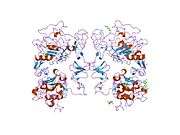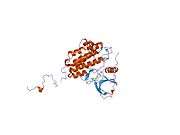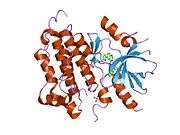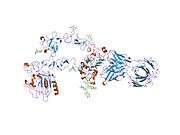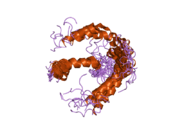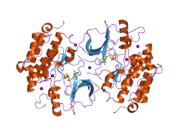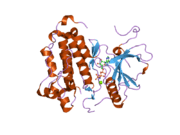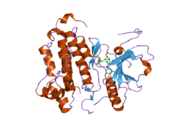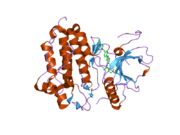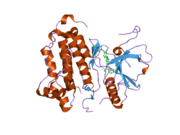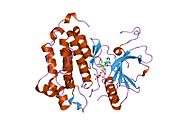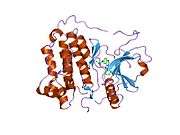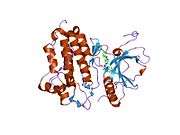Epidermal growth factor receptor
The epidermal growth factor receptor (EGFR; ErbB-1; HER1 in humans) is the cell-surface receptor for members of the epidermal growth factor family (EGF-family) of extracellular protein ligands.[2]
The epidermal growth factor receptor is a member of the ErbB family of receptors, a subfamily of four closely related receptor tyrosine kinases: EGFR (ErbB-1), HER2/c-neu (ErbB-2), Her 3 (ErbB-3) and Her 4 (ErbB-4). Mutations affecting EGFR expression or activity could result in cancer.[3]
Epidermal growth factor and its receptor was discovered by Stanley Cohen of Vanderbilt University. Cohen shared the 1986 Nobel Prize in Medicine with Rita Levi-Montalcini for their discovery of growth factors.
Function

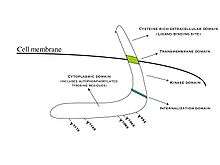
Epidermal growth factor receptor (EGFR) exists on the cell surface and is activated by binding of its specific ligands, including epidermal growth factor and transforming growth factor α (TGFα) (note, a full list of the ligands able to activate EGFR and other members of the ErbB family is given in the ErbB article). ErbB2 has no known direct activating ligand, and may be in an activated state constitutively or become active upon heterodimerization with other family members such as EGFR. Upon activation by its growth factor ligands, EGFR undergoes a transition from an inactive monomeric form to an active homodimer[4] – although there is some evidence that preformed inactive dimers may also exist before ligand binding. In addition to forming homodimers after ligand binding, EGFR may pair with another member of the ErbB receptor family, such as ErbB2/Her2/neu, to create an activated heterodimer. There is also evidence to suggest that clusters of activated EGFRs form, although it remains unclear whether this clustering is important for activation itself or occurs subsequent to activation of individual dimers.
EGFR dimerization stimulates its intrinsic intracellular protein-tyrosine kinase activity. As a result, autophosphorylation of several tyrosine (Y) residues in the C-terminal domain of EGFR occurs. These include Y992, Y1045, Y1068, Y1148 and Y1173, as shown in the diagram to the left.[5] This autophosphorylation elicits downstream activation and signaling by several other proteins that associate with the phosphorylated tyrosines through their own phosphotyrosine-binding SH2 domains. These downstream signaling proteins initiate several signal transduction cascades, principally the MAPK, Akt and JNK pathways, leading to DNA synthesis and cell proliferation.[6] Such proteins modulate phenotypes such as cell migration, adhesion, and proliferation. Activation of the receptor is important for the innate immune response in human skin. The kinase domain of EGFR can also cross-phosphorylate tyrosine residues of other receptors it is aggregated with, and can itself be activated in that manner.
Biological roles
The EGFR is essential for ductal development of the mammary glands,[7][8][9] and agonists of the EGFR such as amphiregulin, TGF-α, and heregulin induce both ductal and lobuloalveolar development even in the absence of estrogen and progesterone.[10][11]
Role in human disease
Cancer
Mutations that lead to EGFR overexpression (known as upregulation) or overactivity have been associated with a number of cancers, including lung cancer, anal cancers[12] and glioblastoma multiforme. These somatic mutations involving EGFR lead to its constant activation, which produces uncontrolled cell division.[13] In glioblastoma a more or less specific mutation of EGFR, called EGFRvIII is often observed.[14] Mutations, amplifications or misregulations of EGFR or family members are implicated in about 30% of all epithelial cancers.
Inflammatory disease
Aberrant EGFR signaling has been implicated in psoriasis, eczema and atherosclerosis.[15][16] However, its exact roles in these conditions are ill-defined.
Monogenic disease
A single child displaying multi-organ epithelial inflammation was found to have a homozygous loss of function mutation in the EGFR gene. The pathogenicity of the EGFR mutation was supported by in vitro experiments and functional analysis of a skin biopsy. His severe phenotype reflects many previous research findings into EGFR function. His clinical features included a papulopustular rash, dry skin, chronic diarrhea, abnormalities of hair growth, breathing difficulties and electrolyte imbalances.[17]
Medical applications
Cancer treatment
The identification of EGFR as an oncogene has led to the development of anticancer therapeutics directed against EGFR (called "EGFR inhibitors"), including gefitinib,[18] erlotinib, afatinib, brigatinib and icotinib[19] for lung cancer, and cetuximab for colon cancer.
Many therapeutic approaches are aimed at the EGFR. Cetuximab and panitumumab are examples of monoclonal antibody inhibitors. However the former is of the IgG1 type, the latter of the IgG2 type; consequences on antibody-dependent cellular cytotoxicity can be quite different.[20] Other monoclonals in clinical development are zalutumumab, nimotuzumab, and matuzumab. The monoclonal antibodies block the extracellular ligand binding domain. With the binding site blocked, signal molecules can no longer attach there and activate the tyrosine kinase.
Another method is using small molecules to inhibit the EGFR tyrosine kinase, which is on the cytoplasmic side of the receptor. Without kinase activity, EGFR is unable to activate itself, which is a prerequisite for binding of downstream adaptor proteins. Ostensibly by halting the signaling cascade in cells that rely on this pathway for growth, tumor proliferation and migration is diminished. Gefitinib, erlotinib, brigatinib and lapatinib (mixed EGFR and ERBB2 inhibitor) are examples of small molecule kinase inhibitors.
CimaVax-EGF, an active vaccine targeting EGF as the major ligand of EGF, uses a different approach, raising antibodies against EGF itself, thereby denying EGFR-dependent cancers of a proliferative stimulus;[21] it is in use as a cancer therapy against non-small-cell lung carcinoma (the most common form of lung cancer) in Cuba, and is undergoing further trials for possible licensing in Japan, Europe, and the United States.[22]
There are several quantitative methods available that use protein phosphorylation detection to identify EGFR family inhibitors.[23]
New drugs such as gefitinib, erlotinib and brigatinib directly target the EGFR. Patients have been divided into EGFR-positive and EGFR-negative, based upon whether a tissue test shows a mutation. EGFR-positive patients have shown a 60% response rate, which exceeds the response rate for conventional chemotherapy.[24]
However, many patients develop resistance. Two primary sources of resistance are the T790M Mutation and MET oncogene.[24] However, as of 2010 there was no consensus of an accepted approach to combat resistance nor FDA approval of a specific combination. Clinical trial phase II results reported for brigatinib targeting the T790M mutation, and brigatinib received Breakthrough Therapy designation status by FDA in Feb. 2015.
The most common adverse effect of EGFR inhibitors, found in more than 90% of patients, is a papulopustular rash that spreads across the face and torso; the rash's presence is correlated with the drug's antitumor effect.[25] In 10% to 15% of patients the effects can be serious and require treatment.[26][27]
Some tests are aiming at predicting benefit from EGFR treatment, as Veristrat.[28]
Laboratory research using genetically engineered stem cells to target EGFR in mice was reported in 2014 to show promise.[29]
Interactions
Epidermal growth factor receptor has been shown to interact with:
- AR,[30][31]
- ARF4,[32]
- CAV1,[33]
- CAV3,[33]
- CBL,[34][35][36][37][38]
- CBLB,[35][39]
- CBLC,[40][41]
- CD44,[42]
- CDC25A,[43]
- CRK,[39][44]
- CTNNB1,[45][46][47]
- DCN,[48][49]
- EGF,[50][51]
- GRB14,[52]
- Grb2,[39][50][52][53][54][55][56][57][58][59]
- JAK2,[60]
- MUC1,[61][62]
- NCK1,[53][63][64]
- NCK2[53][65][66]
- PKC alpha,[67]
- PLCG1,[34][68]
- PLSCR1,[69]
- PTPN1,[70][71]
- PTPN11,[39][72]
- PTPN6,[72][73]
- PTPRK,[74]
- SH2D3A,[75]
- SH3KBP1,[76][77]
- SHC1,[39][78]
- SOS1,[58][79][80]
- Src,[60][81][82]
- STAT1,[60][83]
- STAT3,[60][84]
- STAT5A,[39][60]
- UBC,[36][37][85] and
- WAS.[86]
References
- ↑ Ferguson KM, Berger MB, Mendrola JM, Cho HS, Leahy DJ, Lemmon MA (2003). "EGF activates its receptor by removing interactions that autoinhibit ectodomain dimerization". Mol. Cell 11 (2): 507–17. doi:10.1016/S1097-2765(03)00047-9. PMID 12620237.
- ↑ Herbst RS (2004). "Review of epidermal growth factor receptor biology". Int. J. Radiat. Oncol. Biol. Phys. 59 (2 Suppl): 21–6. doi:10.1016/j.ijrobp.2003.11.041. PMID 15142631.
- ↑ Zhang H, Berezov A, Wang Q, Zhang G, Drebin J, Murali R, Greene MI (August 2007). "ErbB receptors: from oncogenes to targeted cancer therapies". J. Clin. Invest. 117 (8): 2051–8. doi:10.1172/JCI32278. PMC 1934579. PMID 17671639.
- ↑ Yosef Yarden and Joseph Schlessinger (1987). "Epidermal Growth-Factor Induces Rapid, Reversible Aggregation of the Purified Epidermal Growth-Factor Receptor". Biochemistry 26 (5): 1443–1451. doi:10.1021/bi00379a035. PMID 3494473.
- ↑ Downward J, Parker P, Waterfield MD (1984). "Autophosphorylation sites on the epidermal growth factor receptor". Nature 311 (5985): 483–5. doi:10.1038/311483a0. PMID 6090945.
- ↑ Oda K, Matsuoka Y, Funahashi A, Kitano H (2005). "A comprehensive pathway map of epidermal growth factor receptor signaling". Mol. Syst. Biol. 1 (1): 2005.0010. doi:10.1038/msb4100014. PMC 1681468. PMID 16729045.
- ↑ Sebastian J, Richards RG, Walker MP, Wiesen JF, Werb Z, Derynck R, Hom YK, Cunha GR, DiAugustine RP (1998). "Activation and function of the epidermal growth factor receptor and erbB-2 during mammary gland morphogenesis". Cell Growth Differ. 9 (9): 777–85. PMID 9751121.
- ↑ McBryan J, Howlin J, Napoletano S, Martin F (2008). "Amphiregulin: role in mammary gland development and breast cancer". J Mammary Gland Biol Neoplasia 13 (2): 159–69. doi:10.1007/s10911-008-9075-7. PMID 18398673.
- ↑ Sternlicht MD, Sunnarborg SW (2008). "The ADAM17-amphiregulin-EGFR axis in mammary development and cancer". J Mammary Gland Biol Neoplasia 13 (2): 181–94. doi:10.1007/s10911-008-9084-6. PMC 2723838. PMID 18470483.
- ↑ Kenney NJ, Bowman A, Korach KS, Barrett JC, Salomon DS (2003). "Effect of exogenous epidermal-like growth factors on mammary gland development and differentiation in the estrogen receptor-alpha knockout (ERKO) mouse". Breast Cancer Res. Treat. 79 (2): 161–73. doi:10.1023/a:1023938510508. PMID 12825851.
- ↑ Kenney NJ, Smith GH, Rosenberg K, Cutler ML, Dickson RB (1996). "Induction of ductal morphogenesis and lobular hyperplasia by amphiregulin in the mouse mammary gland". Cell Growth Differ. 7 (12): 1769–81. PMID 8959346.
- ↑ Walker F, Abramowitz L, Benabderrahmane D, Duval X, Descatoire V, Hénin D, Lehy T, Aparicio T (November 2009). "Growth factor receptor expression in anal squamous lesions: modifications associated with oncogenic human papillomavirus and human immunodeficiency virus". Hum. Pathol. 40 (11): 1517–27. doi:10.1016/j.humpath.2009.05.010. PMID 19716155.
- ↑ Lynch TJ, Bell DW, Sordella R, Gurubhagavatula S, Okimoto RA, Brannigan BW, Harris PL, Haserlat SM, Supko JG, Haluska FG, Louis DN, Christiani DC, Settleman J, Haber DA (May 2004). "Activating mutations in the epidermal growth factor receptor underlying responsiveness of non-small-cell lung cancer to gefitinib". N. Engl. J. Med. 350 (21): 2129–39. doi:10.1056/NEJMoa040938. PMID 15118073.
- ↑ Kuan CT, Wikstrand CJ, Bigner DD (June 2001). "EGF mutant receptor vIII as a molecular target in cancer therapy". Endocr. Relat. Cancer 8 (2): 83–96. doi:10.1677/erc.0.0080083. PMID 11397666.
- ↑ Jost M, Kari C, Rodeck U (2000). "The EGF receptor - an essential regulator of multiple epidermal functions". Eur J Dermatol 10 (7): 505–10. PMID 11056418.
- ↑ Dreux AC, Lamb DJ, Modjtahedi H, Ferns GA (2006). "The epidermal growth factor receptors and their family of ligands: their putative role in atherogenesis". Atherosclerosis 186 (1): 38–53. doi:10.1016/j.atherosclerosis.2005.06.038. PMID 16076471.
- ↑ Campbell P, Morton P, Takeichi T, Salam A, Roberts N, Proudfoot LE, Mellerio JE, Aminu K, Wellington C, Patil SN, Akiyama M, Liu L, McMillan JR, Aristodemou S, Ishida-Yamamoto A, Abdul-Wahab A, Petrof G, Fong K, Harnchoowong S, Stone K, Harper JI, McLean WH, Simpson MA, Parsons M, McGrath JA (2014). "Epithelial Inflammation Resulting from an Inherited Loss-of-Function Mutation in EGFR". J. Invest. Dermatol. 134 (10): 2570–2578. doi:10.1038/jid.2014.164. PMID 24691054.
- ↑ Paez JG, Jänne PA, Lee JC, Tracy S, Greulich H, Gabriel S, Herman P, Kaye FJ, Lindeman N, Boggon TJ, Naoki K, Sasaki H, Fujii Y, Eck MJ, Sellers WR, Johnson BE, Meyerson M' (June 2004). "EGFR mutations in lung cancer: correlation with clinical response to gefitinib therapy". Science 304 (5676): 1497–500. doi:10.1126/science.1099314. PMID 15118125.
- ↑ Liang, Wenhua; Wu, Xuan; Fang, Wenfeng; Zhao, Yuanyuan; Yang, Yunpeng; Hu, Zhihuang; Xue, Cong; Zhang, Jing; Zhang, Jianwei; Ma, Yuxiang; Zhou, Ting; Yan, Yue; Hou, Xue; Qin, Tao; Dinglin, Xiaoxiao; Tian, Ying; Huang, Peiyu; Huang, Yan; Zhao, Hongyun; Zhang, Li; Ganti, Apar Kishor (12 February 2014). "Network Meta-Analysis of Erlotinib, Gefitinib, Afatinib and Icotinib in Patients with Advanced Non-Small-Cell Lung Cancer Harboring EGFR Mutations". PLoS ONE 9 (2): e85245. doi:10.1371/journal.pone.0085245.
- ↑ Yan L, Beckman RA (October 2005). "Pharmacogenetics and pharmacogenomics in oncology therapeutic antibody development". BioTechniques 39 (4): 565–8. doi:10.2144/000112043. PMID 16235569.
- ↑ Rodríguez, Pedro C; Rodríguez, Gryssell; González, Giselaa; Lage, Agustín (Winter 2010). "Clinical development and perspectives of CIMAvax EGF, Cuban vaccine for non-small-cell lung cancer therapy". MEDICC Rev 12 (1): 17–23. PMID 20387330. Retrieved 13 May 2015.
- ↑ Patel, Neel (11 May 2015). "Cuba Has a Lung Cancer Vaccine—And America Wants It". Wired. Retrieved 13 May 2015.
- ↑ Olive DM (October 2004). "Quantitative methods for the analysis of protein phosphorylation in drug development". Expert Rev Proteomics 1 (3): 327–41. doi:10.1586/14789450.1.3.327. PMID 15966829.
- 1 2 Jackman DM, Miller VA, Cioffredi LA, Yeap BY, Jänne PA, Riely GJ, Ruiz MG, Giaccone G, Sequist LV, Johnson BE (August 2009). "Impact of epidermal growth factor receptor and KRAS mutations on clinical outcomes in previously untreated non-small cell lung cancer patients: results of an online tumor registry of clinical trials". Clin. Cancer Res. 15 (16): 5267–73. doi:10.1158/1078-0432.CCR-09-0888. PMC 3219530. PMID 19671843.
- ↑ Liu HB, Wu Y, Lv TF, Yao YW, Xiao YY, Yuan DM, Song Y (2013). "Skin rash could predict the response to EGFR tyrosine kinase inhibitor and the prognosis for patients with non-small cell lung cancer: a systematic review and meta-analysis". PLoS ONE 8 (1): e55128. doi:10.1371/journal.pone.0055128. PMC 3559430. PMID 23383079.
- ↑ Gerber PA, Meller S, Eames T, Buhren BA, Schrumpf H, Hetzer S, Ehmann LM, Budach W, Bölke E, Matuschek C, Wollenberg A, Homey B (2012). "Management of EGFR-inhibitor associated rash: a retrospective study in 49 patients". Eur. J. Med. Res. 17 (1): 4. doi:10.1186/2047-783X-17-4. PMC 3351712. PMID 22472354.
- ↑ Lacouture ME (2006). "Mechanisms of cutaneous toxicities to EGFR inhibitors". Nat. Rev. Cancer 6 (10): 803–12. doi:10.1038/nrc1970. PMID 16990857.
- ↑ Molina-Pinelo S, Pastor MD, Paz-Ares L (2014). "VeriStrat: a prognostic and/or predictive biomarker for advanced lung cancer patients?". Expert Rev Respir Med 8 (1): 1–4. doi:10.1586/17476348.2014.861744. PMID 24308656.
- ↑ Stuckey DW, Hingtgen SD, Karakas N, Rich BE, Shah K (Feb 2015). "Engineering toxin-resistant therapeutic stem cells to treat brain tumors". Stem Cells 33 (2): 589–600. doi:10.1002/stem.1874. PMID 25346520.
- ↑ Bonaccorsi L, Carloni Vinicio, Muratori Monica, Formigli Lucia, Zecchi Sandra, Forti Gianni, Baldi Elisabetta (Oct 2004). "EGF receptor (EGFR) signaling promoting invasion is disrupted in androgen-sensitive prostate cancer cells by an interaction between EGFR and androgen receptor (AR)". Int. J. Cancer 112 (1): 78–86. doi:10.1002/ijc.20362. PMID 15305378.
- ↑ Bonaccorsi L, Muratori M, Carloni V, Marchiani S, Formigli L, Forti G, Baldi E (Aug 2004). "The androgen receptor associates with the epidermal growth factor receptor in androgen-sensitive prostate cancer cells". Steroids 69 (8-9): 549–52. doi:10.1016/j.steroids.2004.05.011. PMID 15288768.
- ↑ Kim S-W, Hayashi Masaaki, Lo Jeng-Fan, Yang Young, Yoo Jin-San, Lee Jiing-Dwan (Jan 2003). "ADP-ribosylation factor 4 small GTPase mediates epidermal growth factor receptor-dependent phospholipase D2 activation". J. Biol. Chem. 278 (4): 2661–8. doi:10.1074/jbc.M205819200. PMID 12446727.
- 1 2 Couet J, Sargiacomo M, Lisanti M P (Nov 1997). "Interaction of a receptor tyrosine kinase, EGF-R, with caveolins. Caveolin binding negatively regulates tyrosine and serine/threonine kinase activities". J. Biol. Chem. 272 (48): 30429–38. doi:10.1074/jbc.272.48.30429. PMID 9374534.
- 1 2 Tvorogov D, Carpenter Graham (Jul 2002). "EGF-dependent association of phospholipase C-gamma1 with c-Cbl". Exp. Cell Res. 277 (1): 86–94. doi:10.1006/excr.2002.5545. PMID 12061819.
- 1 2 Ettenberg SA, Keane M M, Nau M M, Frankel M, Wang L M, Pierce J H, Lipkowitz S (Mar 1999). "cbl-b inhibits epidermal growth factor receptor signaling". Oncogene 18 (10): 1855–66. doi:10.1038/sj.onc.1202499. PMID 10086340.
- 1 2 Pennock S, Wang Zhixiang (May 2008). "A tale of two Cbls: interplay of c-Cbl and Cbl-b in epidermal growth factor receptor downregulation". Mol. Cell. Biol. 28 (9): 3020–37. doi:10.1128/MCB.01809-07. PMC 2293090. PMID 18316398.
- 1 2 Umebayashi K, Stenmark Harald, Yoshimori Tamotsu (Aug 2008). "Ubc4/5 and c-Cbl continue to ubiquitinate EGF receptor after internalization to facilitate polyubiquitination and degradation". Mol. Biol. Cell 19 (8): 3454–62. doi:10.1091/mbc.E07-10-0988. PMC 2488299. PMID 18508924.
- ↑ Ng C, Jackson Rebecca A, Buschdorf Jan P, Sun Qingxiang, Guy Graeme R, Sivaraman J (Mar 2008). "Structural basis for a novel intrapeptidyl H-bond and reverse binding of c-Cbl-TKB domain substrates". EMBO J. 27 (5): 804–16. doi:10.1038/emboj.2008.18. PMC 2265755. PMID 18273061.
- 1 2 3 4 5 6 Schulze WX, Deng Lei, Mann Matthias (2005). "Phosphotyrosine interactome of the ErbB-receptor kinase family". Mol. Syst. Biol. 1 (1): 2005.0008. doi:10.1038/msb4100012. PMC 1681463. PMID 16729043.
- ↑ Kim M, Tezuka T, Suziki Y, Sugano S, Hirai M, Yamamoto T (Oct 1999). "Molecular cloning and characterization of a novel cbl-family gene, cbl-c". Gene 239 (1): 145–54. doi:10.1016/S0378-1119(99)00356-X. PMID 10571044.
- ↑ Keane MM, Ettenberg S A, Nau M M, Banerjee P, Cuello M, Penninger J, Lipkowitz S (Jun 1999). "cbl-3: a new mammalian cbl family protein". Oncogene 18 (22): 3365–75. doi:10.1038/sj.onc.1202753. PMID 10362357.
- ↑ Midgley AC, Rogers M, Hallett MB, Clayton A, Bowen T, Phillips AO, Steadman R (May 2013). "TGF-(beta)1-stimulated fibroblast to myofibroblast differentiation is mediated by hyaluronan-facilitated EGFR and CD44 co-localization in lipid rafts". J. Biol. Chem. 288 (21): 14824–38. doi:10.1074/jbc.M113.451336. PMC 3663506. PMID 23589287.
- ↑ Wang Z, Wang Meifang, Lazo John S, Carr Brian I (May 2002). "Identification of epidermal growth factor receptor as a target of Cdc25A protein phosphatase". J. Biol. Chem. 277 (22): 19470–5. doi:10.1074/jbc.M201097200. PMID 11912208.
- ↑ Hashimoto Y, Katayama H, Kiyokawa E, Ota S, Kurata T, Gotoh N, Otsuka N, Shibata M, Matsuda M (Jul 1998). "Phosphorylation of CrkII adaptor protein at tyrosine 221 by epidermal growth factor receptor". J. Biol. Chem. 273 (27): 17186–91. doi:10.1074/jbc.273.27.17186. PMID 9642287.
- ↑ Hazan RB, Norton L (Apr 1998). "The epidermal growth factor receptor modulates the interaction of E-cadherin with the actin cytoskeleton". J. Biol. Chem. 273 (15): 9078–84. doi:10.1074/jbc.273.15.9078. PMID 9535896.
- ↑ Schroeder JA, Adriance Melissa C, McConnell Elizabeth J, Thompson Melissa C, Pockaj Barbara, Gendler Sandra J (Jun 2002). "ErbB-beta-catenin complexes are associated with human infiltrating ductal breast and murine mammary tumor virus (MMTV)-Wnt-1 and MMTV-c-Neu transgenic carcinomas". J. Biol. Chem. 277 (25): 22692–8. doi:10.1074/jbc.M201975200. PMID 11950845.
- ↑ Takahashi K, Suzuki K, Tsukatani Y (Jul 1997). "Induction of tyrosine phosphorylation and association of beta-catenin with EGF receptor upon tryptic digestion of quiescent cells at confluence". Oncogene 15 (1): 71–8. doi:10.1038/sj.onc.1201160. PMID 9233779.
- ↑ Santra M, Reed Charles C, Iozzo Renato V (Sep 2002). "Decorin binds to a narrow region of the epidermal growth factor (EGF) receptor, partially overlapping but distinct from the EGF-binding epitope". J. Biol. Chem. 277 (38): 35671–81. doi:10.1074/jbc.M205317200. PMID 12105206.
- ↑ Iozzo RV, Moscatello D K, McQuillan D J, Eichstetter I (Feb 1999). "Decorin is a biological ligand for the epidermal growth factor receptor". J. Biol. Chem. 274 (8): 4489–92. doi:10.1074/jbc.274.8.4489. PMID 9988678.
- 1 2 Wong L, Deb T B, Thompson S A, Wells A, Johnson G R (Mar 1999). "A differential requirement for the COOH-terminal region of the epidermal growth factor (EGF) receptor in amphiregulin and EGF mitogenic signaling". J. Biol. Chem. 274 (13): 8900–9. doi:10.1074/jbc.274.13.8900. PMID 10085134.
- ↑ Stortelers C, Souriau Christelle, van Liempt Ellis, van de Poll Monique L M, van Zoelen Everardus J J (Jul 2002). "Role of the N-terminus of epidermal growth factor in ErbB-2/ErbB-3 binding studied by phage display". Biochemistry 41 (27): 8732–41. doi:10.1021/bi025878c. PMID 12093292.
- 1 2 Daly RJ, Sanderson G M, Janes P W, Sutherland R L (May 1996). "Cloning and characterization of GRB14, a novel member of the GRB7 gene family". J. Biol. Chem. 271 (21): 12502–10. doi:10.1074/jbc.271.21.12502. PMID 8647858.
- 1 2 3 Braverman LE, Quilliam L A (Feb 1999). "Identification of Grb4/Nckbeta, a src homology 2 and 3 domain-containing adapter protein having similar binding and biological properties to Nck". J. Biol. Chem. 274 (9): 5542–9. doi:10.1074/jbc.274.9.5542. PMID 10026169.
- ↑ Blagoev B, Kratchmarova Irina, Ong Shao-En, Nielsen Mogens, Foster Leonard J, Mann Matthias (Mar 2003). "A proteomics strategy to elucidate functional protein-protein interactions applied to EGF signaling". Nat. Biotechnol. 21 (3): 315–8. doi:10.1038/nbt790. PMID 12577067.
- ↑ Oneyama C, Nakano Hirofumi, Sharma Sreenath V (Mar 2002). "UCS15A, a novel small molecule, SH3 domain-mediated protein-protein interaction blocking drug". Oncogene 21 (13): 2037–50. doi:10.1038/sj.onc.1205271. PMID 11960376.
- ↑ Okutani T, Okabayashi Y, Kido Y, Sugimoto Y, Sakaguchi K, Matuoka K, Takenawa T, Kasuga M (Dec 1994). "Grb2/Ash binds directly to tyrosines 1068 and 1086 and indirectly to tyrosine 1148 of activated human epidermal growth factor receptors in intact cells". J. Biol. Chem. 269 (49): 31310–4. PMID 7527043.
- ↑ Tortora G, Damiano V, Bianco C, Baldassarre G, Bianco A R, Lanfrancone L, Pelicci P G, Ciardiello F (Feb 1997). "The RIalpha subunit of protein kinase A (PKA) binds to Grb2 and allows PKA interaction with the activated EGF-receptor". Oncogene 14 (8): 923–8. doi:10.1038/sj.onc.1200906. PMID 9050991.
- 1 2 Buday L, Egan S E, Rodriguez Viciana P, Cantrell D A, Downward J (Mar 1994). "A complex of Grb2 adaptor protein, Sos exchange factor, and a 36-kDa membrane-bound tyrosine phosphoprotein is implicated in ras activation in T cells". J. Biol. Chem. 269 (12): 9019–23. PMID 7510700.
- ↑ Lowenstein EJ, Daly R J, Batzer A G, Li W, Margolis B, Lammers R, Ullrich A, Skolnik E Y, Bar-Sagi D, Schlessinger J (Aug 1992). "The SH2 and SH3 domain-containing protein GRB2 links receptor tyrosine kinases to ras signaling". Cell 70 (3): 431–42. doi:10.1016/0092-8674(92)90167-B. PMID 1322798.
- 1 2 3 4 5 Olayioye MA, Beuvink I, Horsch K, Daly J M, Hynes N E (Jun 1999). "ErbB receptor-induced activation of stat transcription factors is mediated by Src tyrosine kinases". J. Biol. Chem. 274 (24): 17209–18. doi:10.1074/jbc.274.24.17209. PMID 10358079.
- ↑ Schroeder JA, Thompson M C, Gardner M M, Gendler S J (Apr 2001). "Transgenic MUC1 interacts with epidermal growth factor receptor and correlates with mitogen-activated protein kinase activation in the mouse mammary gland". J. Biol. Chem. 276 (16): 13057–64. doi:10.1074/jbc.M011248200. PMID 11278868.
- ↑ Li Y, Ren J, Yu W, Li Q, Kuwahara H, Yin L, Carraway K L, Kufe D (Sep 2001). "The epidermal growth factor receptor regulates interaction of the human DF3/MUC1 carcinoma antigen with c-Src and beta-catenin". J. Biol. Chem. 276 (38): 35239–42. doi:10.1074/jbc.C100359200. PMID 11483589.
- ↑ Tang J, Feng G S, Li W (Oct 1997). "Induced direct binding of the adapter protein Nck to the GTPase-activating protein-associated protein p62 by epidermal growth factor". Oncogene 15 (15): 1823–32. doi:10.1038/sj.onc.1201351. PMID 9362449.
- ↑ Li W, Hu P, Skolnik E Y, Ullrich A, Schlessinger J (Dec 1992). "The SH2 and SH3 domain-containing Nck protein is oncogenic and a common target for phosphorylation by different surface receptors". Mol. Cell. Biol. 12 (12): 5824–33. doi:10.1128/MCB.12.12.5824. PMC 360522. PMID 1333047.
- ↑ Chen M, She H, Davis E M, Spicer C M, Kim L, Ren R, Le Beau M M, Li W (Sep 1998). "Identification of Nck family genes, chromosomal localization, expression, and signaling specificity". J. Biol. Chem. 273 (39): 25171–8. doi:10.1074/jbc.273.39.25171. PMID 9737977.
- ↑ Tu Y, Li F, Wu C (Dec 1998). "Nck-2, a novel Src homology2/3-containing adaptor protein that interacts with the LIM-only protein PINCH and components of growth factor receptor kinase-signaling pathways". Mol. Biol. Cell 9 (12): 3367–82. doi:10.1091/mbc.9.12.3367. PMC 25640. PMID 9843575.
- ↑ Gauthier ML, Torretto Cheryl, Ly John, Francescutti Valerie, O'Day Danton H (Aug 2003). "Protein kinase Calpha negatively regulates cell spreading and motility in MDA-MB-231 human breast cancer cells downstream of epidermal growth factor receptor". Biochem. Biophys. Res. Commun. 307 (4): 839–46. doi:10.1016/S0006-291X(03)01273-7. PMID 12878187.
- ↑ Bedrin MS, Abolafia C M, Thompson J F (Jul 1997). "Cytoskeletal association of epidermal growth factor receptor and associated signaling proteins is regulated by cell density in IEC-6 intestinal cells". J. Cell. Physiol. 172 (1): 126–36. doi:10.1002/(SICI)1097-4652(199707)172:1<126::AID-JCP14>3.0.CO;2-A. PMID 9207933.
- ↑ Sun J, Nanjundan Meera, Pike Linda J, Wiedmer Therese, Sims Peter J (May 2002). "Plasma membrane phospholipid scramblase 1 is enriched in lipid rafts and interacts with the epidermal growth factor receptor". Biochemistry 41 (20): 6338–45. doi:10.1021/bi025610l. PMID 12009895.
- ↑ Sarmiento M, Puius Y A, Vetter S W, Keng Y F, Wu L, Zhao Y, Lawrence D S, Almo S C, Zhang Z Y (Jul 2000). "Structural basis of plasticity in protein tyrosine phosphatase 1B substrate recognition". Biochemistry 39 (28): 8171–9. doi:10.1021/bi000319w. PMID 10889023.
- ↑ Zhang ZY, Walsh A B, Wu L, McNamara D J, Dobrusin E M, Miller W T (Mar 1996). "Determinants of substrate recognition in the protein-tyrosine phosphatase, PTP1". J. Biol. Chem. 271 (10): 5386–92. doi:10.1074/jbc.271.10.5386. PMID 8621392.
- 1 2 Tomic S, Greiser U, Lammers R, Kharitonenkov A, Imyanitov E, Ullrich A, Böhmer F D (Sep 1995). "Association of SH2 domain protein tyrosine phosphatases with the epidermal growth factor receptor in human tumor cells. Phosphatidic acid activates receptor dephosphorylation by PTP1C". J. Biol. Chem. 270 (36): 21277–84. doi:10.1074/jbc.270.36.21277. PMID 7673163.
- ↑ Keilhack H, Tenev T, Nyakatura E, Godovac-Zimmermann J, Nielsen L, Seedorf K, Böhmer F D (Sep 1998). "Phosphotyrosine 1173 mediates binding of the protein-tyrosine phosphatase SHP-1 to the epidermal growth factor receptor and attenuation of receptor signaling". J. Biol. Chem. 273 (38): 24839–46. doi:10.1074/jbc.273.38.24839. PMID 9733788.
- ↑ Wang SE, Wu FY, Shin I, Qu S, Arteaga CL (2005). "Transforming growth factor {beta} (TGF-{beta})-Smad target gene protein tyrosine phosphatase receptor type kappa is required for TGF-{beta} function.". Mol Cell Biol 25 (11): 4703–15. doi:10.1128/MCB.25.11.4703-4715.2005. PMC 1140650. PMID 15899872.
- ↑ Lu Y, Brush J, Stewart T A (Apr 1999). "NSP1 defines a novel family of adaptor proteins linking integrin and tyrosine kinase receptors to the c-Jun N-terminal kinase/stress-activated protein kinase signaling pathway". J. Biol. Chem. 274 (15): 10047–52. doi:10.1074/jbc.274.15.10047. PMID 10187783.
- ↑ Soubeyran P, Kowanetz Katarzyna, Szymkiewicz Iwona, Langdon Wallace Y, Dikic Ivan (Mar 2002). "Cbl-CIN85-endophilin complex mediates ligand-induced downregulation of EGF receptors". Nature 416 (6877): 183–7. doi:10.1038/416183a. PMID 11894095.
- ↑ Szymkiewicz I, Kowanetz Katarzyna, Soubeyran Philippe, Dinarina Ana, Lipkowitz Stanley, Dikic Ivan (Oct 2002). "CIN85 participates in Cbl-b-mediated down-regulation of receptor tyrosine kinases". J. Biol. Chem. 277 (42): 39666–72. doi:10.1074/jbc.M205535200. PMID 12177062.
- ↑ Sakaguchi K, Okabayashi Y, Kido Y, Kimura S, Matsumura Y, Inushima K, Kasuga M (Apr 1998). "Shc phosphotyrosine-binding domain dominantly interacts with epidermal growth factor receptors and mediates Ras activation in intact cells". Mol. Endocrinol. 12 (4): 536–43. doi:10.1210/me.12.4.536. PMID 9544989.
- ↑ Qian X, Esteban L, Vass W C, Upadhyaya C, Papageorge A G, Yienger K, Ward J M, Lowy D R, Santos E (Feb 2000). "The Sos1 and Sos2 Ras-specific exchange factors: differences in placental expression and signaling properties". EMBO J. 19 (4): 642–54. doi:10.1093/emboj/19.4.642. PMC 305602. PMID 10675333.
- ↑ Qian X, Vass W C, Papageorge A G, Anborgh P H, Lowy D R (Feb 1998). "N terminus of Sos1 Ras exchange factor: critical roles for the Dbl and pleckstrin homology domains". Mol. Cell. Biol. 18 (2): 771–8. PMC 108788. PMID 9447973.
- ↑ Keely SJ, Calandrella S O, Barrett K E (Apr 2000). "Carbachol-stimulated transactivation of epidermal growth factor receptor and mitogen-activated protein kinase in T(84) cells is mediated by intracellular ca(2+), PYK-2, and p60(src)". J. Biol. Chem. 275 (17): 12619–25. doi:10.1074/jbc.275.17.12619. PMID 10777553.
- ↑ Sato K, Kimoto M, Kakumoto M, Horiuchi D, Iwasaki T, Tokmakov A A, Fukami Y (Sep 2000). "Adaptor protein Shc undergoes translocation and mediates up-regulation of the tyrosine kinase c-Src in EGF-stimulated A431 cells". Genes Cells 5 (9): 749–64. doi:10.1046/j.1365-2443.2000.00358.x. PMID 10971656.
- ↑ Xia L, Wang Lijuan, Chung Alicia S, Ivanov Stanimir S, Ling Mike Y, Dragoi Ana M, Platt Adam, Gilmer Tona M, Fu Xin-Yuan, Chin Y Eugene (Aug 2002). "Identification of both positive and negative domains within the epidermal growth factor receptor COOH-terminal region for signal transducer and activator of transcription (STAT) activation". J. Biol. Chem. 277 (34): 30716–23. doi:10.1074/jbc.M202823200. PMID 12070153.
- ↑ Yuan Z-L, Guan Ying-Jie, Wang Lijuan, Wei Wenyi, Kane Agnes B, Chin Y Eugene (Nov 2004). "Central role of the threonine residue within the p+1 loop of receptor tyrosine kinase in STAT3 constitutive phosphorylation in metastatic cancer cells". Mol. Cell. Biol. 24 (21): 9390–400. doi:10.1128/MCB.24.21.9390-9400.2004. PMC 522220. PMID 15485908.
- ↑ Sehat B, Andersson Sandra, Girnita Leonard, Larsson Olle (Jul 2008). "Identification of c-Cbl as a new ligase for insulin-like growth factor-I receptor with distinct roles from Mdm2 in receptor ubiquitination and endocytosis". Cancer Res. 68 (14): 5669–77. doi:10.1158/0008-5472.CAN-07-6364. PMID 18632619.
- ↑ She HY, Rockow S, Tang J, Nishimura R, Skolnik E Y, Chen M, Margolis B, Li W (Sep 1997). "Wiskott-Aldrich syndrome protein is associated with the adapter protein Grb2 and the epidermal growth factor receptor in living cells". Mol. Biol. Cell 8 (9): 1709–21. doi:10.1091/mbc.8.9.1709. PMC 305731. PMID 9307968.
Further reading
- Carpenter G (1987). "Receptors for epidermal growth factor and other polypeptide mitogens". Annu. Rev. Biochem. 56 (1): 881–914. doi:10.1146/annurev.bi.56.070187.004313. PMID 3039909.
- Boonstra J, Rijken P, Humbel B; et al. (1995). "The epidermal growth factor". Cell Biol. Int. 19 (5): 413–30. doi:10.1006/cbir.1995.1086. PMID 7640657.
- Carpenter G (2000). "The EGF receptor: a nexus for trafficking and signaling". BioEssays 22 (8): 697–707. doi:10.1002/1521-1878(200008)22:8<697::AID-BIES3>3.0.CO;2-1. PMID 10918300.
- Filardo EJ (2002). "Epidermal growth factor receptor (EGFR) transactivation by estrogen via the G-protein-coupled receptor, GPR30: a novel signaling pathway with potential significance for breast cancer". J. Steroid Biochem. Mol. Biol. 80 (2): 231–8. doi:10.1016/S0960-0760(01)00190-X. PMID 11897506.
- Tiganis T (2002). "Protein tyrosine phosphatases: dephosphorylating the epidermal growth factor receptor". IUBMB Life 53 (1): 3–14. doi:10.1080/15216540210811. PMID 12018405.
- Di Fiore PP, Scita G (2002). "Eps8 in the midst of GTPases". Int. J. Biochem. Cell Biol. 34 (10): 1178–83. doi:10.1016/S1357-2725(02)00064-X. PMID 12127568.
- Benaim G, Villalobo A (2002). "Phosphorylation of calmodulin. Functional implications". Eur. J. Biochem. 269 (15): 3619–31. doi:10.1046/j.1432-1033.2002.03038.x. PMID 12153558.
- Leu TH, Maa MC (2004). "Functional implication of the interaction between EGF receptor and c-Src". Front. Biosci. 8 (1-3): s28–38. doi:10.2741/980. PMID 12456372.
- Anderson NL, Anderson NG (2003). "The human plasma proteome: history, character, and diagnostic prospects". Mol. Cell Proteomics 1 (11): 845–67. doi:10.1074/mcp.R200007-MCP200. PMID 12488461.
- Kari C, Chan TO, Rocha de Quadros M, Rodeck U (2003). "Targeting the epidermal growth factor receptor in cancer: apoptosis takes center stage". Cancer Res. 63 (1): 1–5. PMID 12517767.
- Bonaccorsi L, Muratori M, Carloni V; et al. (2003). "Androgen receptor and prostate cancer invasion". Int. J. Androl. 26 (1): 21–5. doi:10.1046/j.1365-2605.2003.00375.x. PMID 12534934.
- Reiter JL, Maihle NJ (2003). "Characterization and expression of novel 60-kDa and 110-kDa EGFR isoforms in human placenta". Annals of the New York Academy of Sciences 995 (1): 39–47. doi:10.1111/j.1749-6632.2003.tb03208.x. PMID 12814937.
- Adams TE, McKern NM, Ward CW (2005). "Signalling by the type 1 insulin-like growth factor receptor: interplay with the epidermal growth factor receptor". Growth Factors 22 (2): 89–95. doi:10.1080/08977190410001700998. PMID 15253384.
- Ferguson KM (2005). "Active and inactive conformations of the epidermal growth factor receptor". Biochem. Soc. Trans. 32 (Pt 5): 742–5. doi:10.1042/BST0320742. PMID 15494003.
- Chao C, Hellmich MR (2005). "Bi-directional signaling between gastrointestinal peptide hormone receptors and epidermal growth factor receptor". Growth Factors 22 (4): 261–8. doi:10.1080/08977190412331286900. PMID 15621729.
- Carlsson J, Ren ZP, Wester K; et al. (2006). "Planning for intracavitary anti-EGFR radionuclide therapy of gliomas. Literature review and data on EGFR expression". J. Neurooncol. 77 (1): 33–45. doi:10.1007/s11060-005-7410-z. PMID 16200342.
- Scartozzi M, Pierantoni C, Berardi R; et al. (2006). "Epidermal growth factor receptor: a promising therapeutic target for colorectal cancer". Anal. Quant. Cytol. Histol. 28 (2): 61–8. PMID 16637508.
- Prudkin L, Wistuba II (2006). "Epidermal growth factor receptor abnormalities in lung cancer. Pathogenetic and clinical implications". Annals of diagnostic pathology 10 (5): 306–15. doi:10.1016/j.anndiagpath.2006.06.011. PMID 16979526.
- Ahmed SM, Salgia R (2007). "Epidermal growth factor receptor mutations and susceptibility to targeted therapy in lung cancer". Respirology 11 (6): 687–92. doi:10.1111/j.1440-1843.2006.00887.x. PMID 17052295.
- Zhang X, Chang A (2007). "Somatic mutations of the epidermal growth factor receptor and non-small-cell lung cancer". J. Med. Genet. 44 (3): 166–72. doi:10.1136/jmg.2006.046102. PMC 2598028. PMID 17158592.
- Cohenuram M, Saif MW (2007). "Epidermal growth factor receptor inhibition strategies in pancreatic cancer: past, present and the future". JOP 8 (1): 4–15. PMID 17228128.
- Mellinghoff IK, Cloughesy TF, Mischel PS (2007). "PTEN-mediated resistance to epidermal growth factor receptor kinase inhibitors". Clin. Cancer Res. 13 (2 Pt 1): 378–81. doi:10.1158/1078-0432.CCR-06-1992. PMID 17255257.
- Nakamura JL (2007). "The epidermal growth factor receptor in malignant gliomas: pathogenesis and therapeutic implications". Expert Opin. Ther. Targets 11 (4): 463–72. doi:10.1517/14728222.11.4.463. PMID 17373877.
External links
- Epidermal Growth Factor Receptor at the US National Library of Medicine Medical Subject Headings (MeSH)
| |||||||||||||||||||||||||||||||||||||||||||||||||||||||||
| ||||||||||||||||||||||||||||||||||||||||||||||||||||||||||||||||||||||||||||||||||
| ||||||||||||||||||||||||||||||||||||||||||||||||
| ||||||||||||||||||||||||||||||||||||||||||||||||||||||||||||||||||||||||||||||||||||||||||||||||||||||||||||||||||||||||||||||||||||||||||||||||
| ||||||||||||||||||
\


